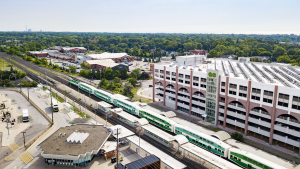No single event in recent times has challenged the construction industry as much as the COVID-19 pandemic. Projects across all sectors globally faced supply and labour issues as never before.
Volumetric modular construction answered the call.
One area under severe pressure was long-term care for the elderly. In response, Infrastructure Ontario (IO) launched the Accelerated Build Model to sharpen issues surrounding hospital land, procurement and design development, schedule innovation and lean principles in order to build urgently required facilities.
An example of the program’s success is Lakeridge Gardens in Ajax, Ont., the province’s first accelerated build project to achieve occupancy. Opened in the spring of 2022, the six-storey, 320-bed long-term care facility went from shovels-in-the-ground to occupancy after only 13 months, a remarkably short time compared with traditional building processes.
Built by PCL �鶹��ý����ion and designed through a partnership between sector design experts G Architects and Parkin Architects, the build process utilized a modular kit-of-parts design approach.
The kit-of-parts approach minimizes up-front design work by organizing the individual parts and raw materials into assemblies of standard easy-to-manufacture components and sized for ease of transport.
This allowed the assembly of washrooms, walls and structure to occur in parallel at the highest level of quality. The construction of the building was then carried out on the assembly level as opposed to the raw material level. The project also benefited from reduced site congestion and noise, important due to its location next to Lakeridge Health’s Ajax Pickering Hospital.
Modular construction has grown over the past few years to 6.14 per cent of the total square footage of new construction last year, according to the Modular Building Institute (MBI) 2022 Annual Report. Of that, health care represented 5.3 per cent. However, that relatively small number belies the importance of the modular process to the sector. Future prospects have observers excited.
In its 2022 Life Sciences report, CRB Horizons said, “63 per cent of respondents identified the use of pre-constructed speculation space (ie. modular) to pursue lab/CGMP site expansion.”
“There’s a pervasive myth in the life science industry that choosing a modular approach means giving up flexibility or control,” the report continues. “In fact, when leveraged appropriately, modularization has the opposite effect: it increases the agility and adaptability of a project’s design. That’s because modularization decreases and defers the burden of making mission-critical design decisions, giving project teams the opportunity to learn, adapt and scale rapidly.”
The overarching advantage modular construction brings to all sectors is speed of project completion. In the case of advanced health sciences that speed advantage may come at a small cost premium, one reason why it has not gained more traction in the past.
However, lab and bio manufacturing projects are becoming increasingly large and complex to build on a custom basis. More developers are recognizing that as an overall package, modular is the way to go.
An example of this is the Levit Green life science project in Houston, Texas, being developed by global property developer Hines and Houston’s 2ML Real Estate Interests.
The 270,000-square-foot lab building that anchors the 52-acre master-planned community adjacent to the Texas Medical Center broke ground last October. The prefabricated walls are not only faster to assemble and flexible in purpose but can be prefinished with the level of resilient finishes required for modern lab facilities demanding the highest levels of cleanliness.
Development of modular processes for health sciences is going even further. Just as COVID drove the fast delivery of vaccines, the speed of delivery of prefabricated lab and bio manufacturing facilities will be critical in future health emergencies.
“Biopharma leaders across the world have long understood speed-to-market as a critical driver for the health of their businesses, and most importantly, the health of patients,” Tim Barba, Chief Operating Officer, Global Technical Operations of CRB writes in the 2022 report.
The report references a multinational mRNA manufacturer using the modular design approach to develop their own standardized CGMP modules for global expansion, modules that fulfill 80 per cent of their base criterion, leaving only 20 per cent to be adapted at each location.
“Whether an organization is building up or building out, we’re seeing a trend of expansion across multiple sites and in some cases, across multiple nations,” the report continues. “In this dynamic industry, investment in strategic planning and design upfront is key to keeping expansion moving at pace and on budget. Achieving standardization and consistency across multiple sites isn’t an exercise in planning for every single ‘what if,’ but rather building agility and adaptability into the design.
“Modular design is becoming a critical component of future success.”









Recent Comments
comments for this post are closed